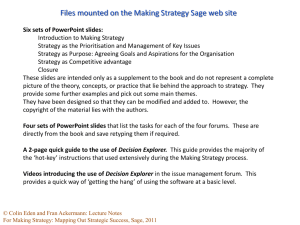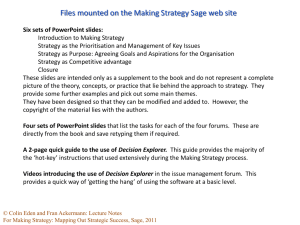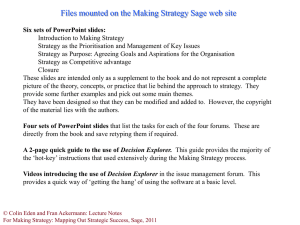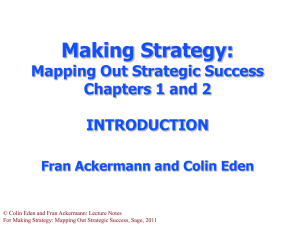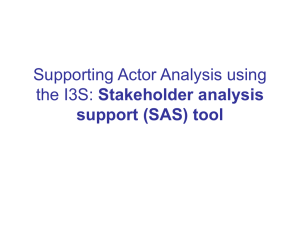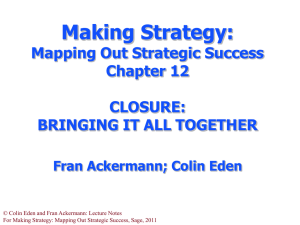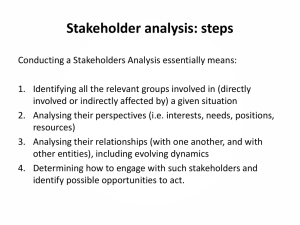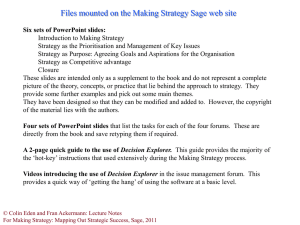DC`s for Gavin - Sage Publications
advertisement
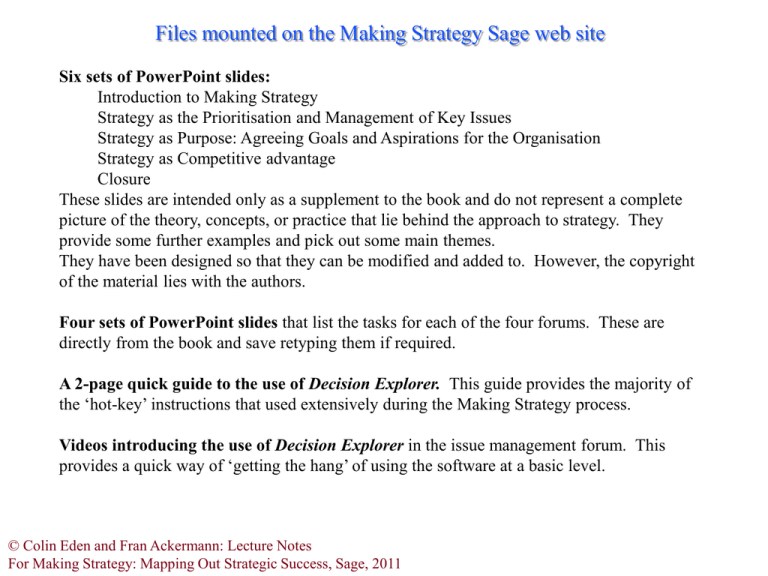
Files mounted on the Making Strategy Sage web site Six sets of PowerPoint slides: Introduction to Making Strategy Strategy as the Prioritisation and Management of Key Issues Strategy as Purpose: Agreeing Goals and Aspirations for the Organisation Strategy as Competitive advantage Closure These slides are intended only as a supplement to the book and do not represent a complete picture of the theory, concepts, or practice that lie behind the approach to strategy. They provide some further examples and pick out some main themes. They have been designed so that they can be modified and added to. However, the copyright of the material lies with the authors. Four sets of PowerPoint slides that list the tasks for each of the four forums. These are directly from the book and save retyping them if required. A 2-page quick guide to the use of Decision Explorer. This guide provides the majority of the ‘hot-key’ instructions that used extensively during the Making Strategy process. Videos introducing the use of Decision Explorer in the issue management forum. This provides a quick way of ‘getting the hang’ of using the software at a basic level. © Colin Eden and Fran Ackermann: Lecture Notes For Making Strategy: Mapping Out Strategic Success, Sage, 2011 Group Explorer There is also available a Group Support System that allows participants to enter statements and links directly in to a publicly displayed Decision Explorer model. The system also allows for the rating of statements, and the indication of preferences about, for example, options to focus on, undesirable options, leverage on goals, etc. The significant benefits of the system are higher productivity, anonymity when appropriate, the ability to monitor development consensus, and facilitator monitoring of levels of participation and type of participation. The system has been used extensively over the past 10 years by a number of Business Schools, managers, and consultants. It has been used with top management teams of MNC’s as well as with pressure groups. The system requires the purchase of the Group Explorer software from Ackermann&Eden at Strathclyde Business School, a full copy of Decision Explorer, Windows Server, and 2 laptop computers (one running Windows Server and the other Windows 7). See: Ackermann, F. and Eden, C. Negotiation in Strategy Making Teams Group Support Systems and the Process of Cognitive Change. Group Decision and Negotiation. 2011; 20(3)293-314. Andersen, D.; Richardson, G. P.; Ackermann, F., and Eden, C. Using a Group Support System to Add Value to Group Model Building. System Dynamics Review. 2010; 26(4)335-346. © Colin Eden and Fran Ackermann: Lecture Notes For Making Strategy: Mapping Out Strategic Success, Sage, 2011 Making Strategy: Mapping Out Strategic Success STRATEGY AS STAKEHOLDER MANAGEMENT Chapters 9 and 10 Fran Ackermann; Colin Eden © Colin Eden and Fran Ackermann: Lecture Notes For Making Strategy: Mapping Out Strategic Success, Sage, 2011 Please note, these slides are designed to be used in addition to the book: Making Strategy: Mapping Out Strategic Success. by Ackermann & Eden, Sage, 2011 They are not designed to be used in a ‘stand-alone’ manner, or to replicate theory and practice presented in the book. The assignment design represents one possibility for a 20 credit MBA course (thus each of the 4 parts represents approx 5 credits + Closure). © Colin Eden and Fran Ackermann: Lecture Notes For Making Strategy: Mapping Out Strategic Success, Sage, 2011 Strategic Management is about agreeing which stakeholders to practically focus energy, cash, effort, emotion © Colin Eden and Fran Ackermann: Lecture Notes For Making Strategy: Mapping Out Strategic Success, Sage, 2011 Making Strategy in 4x~3hr workshops (2 days)…. Or single half day workshops Workshop 1 – morning • Strategy as the Prioritisation and Management of Key Issues • Statement of Strategic Intent Workshop 2 – afternoon • Strategy as Purpose: Agreeing Goals and Aspirations for the Organisation • Statement of Strategic Intent Workshop 3 – morning • Strategy as Competitive advantage • Statement of Strategic Intent Workshop 4 – afternoon • Strategy as Stakeholder Management • Statement of Strategic Intent DELIVERABLE OVERALL: • Statement of strategic intent (SSI) encompassing: issue management, purpose, competitive advantage, stakeholder management © Colin Eden and Fran Ackermann: Lecture Notes For Making Strategy: Mapping Out Strategic Success, Sage, 2011 Stakeholder Management? “The best way to eliminate any enemy is to make him a friend” John M Capozzi, 1997 © Colin Eden and Fran Ackermann: Lecture Notes For Making Strategy: Mapping Out Strategic Success, Sage, 2011 Stakeholder Analysis and Management “... stakeholder analysis has a utilitarian aim; that of identifying stakeholders who will, or can be persuaded to, support actively the strategy of the organization. Organisations will also need to be concerned with those who will seek to sabotage the successful management of the strategy Refer to Chapter 9 © Colin Eden and Fran Ackermann: Lecture Notes For Making Strategy: Mapping Out Strategic Success, Sage, 2011 Why pay attention to stakeholders? Pragmatically because it: • Helps with the competing demands being made on organizations • Recognises and enables management of the interactions that exist between stakeholders • Acknowledges the influence both Internal and External stakeholders can have • Increases the likelihood of change and realisation of aspirations There is also a considerable body of stakeholder literature © Colin Eden and Fran Ackermann: Lecture Notes For Making Strategy: Mapping Out Strategic Success, Sage, 2011 Some Considerations (from the literature) for Successful Stakeholder Management Stakeholder management should: • Apply clear and useful definitions of stakeholders that attend to the stakeholder’s uniqueness • Identify the relative significance of stakeholders • Manage multiple and interdependent interactions between stakeholders and potential stakeholders • Determine how to intervene, when appropriate to develop or alter the bases of individual stakeholder significance Refer to Chapter 9 © Colin Eden and Fran Ackermann: Lecture Notes For Making Strategy: Mapping Out Strategic Success, Sage, 2011 Stakeholder Analysis • Range of complimentary techniques • Power vs. Interest grid • “Sanctions/Interests” Stakeholder Management Web • Actor Influence network maps • Stakeholder role think •Stakeholder dynamics Refer to p240-245 © Colin Eden and Fran Ackermann: Lecture Notes For Making Strategy: Mapping Out Strategic Success, Sage, 2011 Power-Interest Grid Refer to p231-235, 256 • Power to affect what happens (they can take actions that will affect the outcomes of strategy) • Stake in the situation (they like some possible outcomes better than others) Interest (stake) “Subjects” “Players” “Crowd” “Leaders and Context setters” Power © Colin Eden and Fran Ackermann: Lecture Notes For Making Strategy: Mapping Out Strategic Success, Sage, 2011 PARTICIPANTS SUBJECTS Low Power High Interest (could be +ve or –ve) Management could encourage coalitions to increase power of +ve and convert them to players or neutralise -ve PLAYERS High Power High Interest (could be +ve or –ve) Significant stakeholders who deserve sustained management attention CROWD Low Power Low Interest Can be seen as potential rather than actual Stakeholders Interest and/or Power could be raised but unlikely to be worth management time or effort CONTEXT SETTERS High Power Low Interest Can influence future overall context. Management should seek to raise awareness and develop +ve interest and convert them into players POWER © Colin Eden and Fran Ackermann: Lecture Notes For Making Strategy: Mapping Out Strategic Success, Sage, 2011 Refer to p257 Developing the Power-Interest Grid Refer to p231-235, 256 Analysis • Surface a wide range of stakeholders which can be structured on the grid – not untypical to have 100+ in public sector organisations • Dis-aggregate the stakeholders to a ‘management’ level • Separate influencers (power) from stakeholders (interest) – different options • Consider the disposition of stakeholders • Categorise stakeholders (e.g. internal, external, media, government etc) Management • Determines which players must be considered - prioritisation • Reveals instability in interest • Highlights behaviour to be terminated/avoided, coalitions to be encourage, stakeholders to be ‘bought in’ • Suggests new options © Colin Eden and Fran Ackermann: Lecture Notes For Making Strategy: Mapping Out Strategic Success, Sage, 2011 The Power Interest Grid with stakeholders positioned Refer to p261 for an example Interest stakeholder stakeholder stakeholder stakeholder stakeholder stakeholder stakeholder stakeholder stakeholder stakeholder stakeholder stakeholder stakeholder stakeholder stakeholder stakeholder Subjects Players stakeholder stakeholder stakeholder stakeholder stakeholder Potential stakeholder stakeholder Potential stakeholder stakeholder Potential stakeholder stakeholder Potential stakeholder stakeholder Leaders or Context Setters Crowd Potential stakeholder stakeholder Potential stakeholder stakeholder Potential stakeholder stakeholder Potential stakeholder stakeholder Power © Colin Eden and Fran Ackermann: Lecture Notes For Making Strategy: Mapping Out Strategic Success, Sage, 2011 Note: dotted arrows represent the extent and nature of instability and the solid arrows suggest the direction of likely management of the power or interest of stakeholders A P R a n g P r S e R o c r S t e o s A t c S s l M W AS i h t O s a o n a o ( n Ji o R B s n r N i i a aM Ch H l Nc d E sO o e E c d g a d S E n C g C C C l o o W r H a e o S u r i f n a GS o r u r s a e l a e n i n S l n W i l N H p e e o n i Rv n p e o i ( C e o h S g J S C o Ho E w os d y r U E m S n C il i o ( a F E S O C o E l D o l l n c i A P e n g C m o e i e E i n p s r t c s t B B h n i o N R o b r £ s d i n w c g n h P a e e t k m I i E a h t h E g e i g o s r eL rA h o T ic h o i n i d s i i v o i t d o S l S c w o D d a c o n o ( D o n a o f e S c R oa d i f t Fo o o e d o N S i F r ga oi £ p k c l n e ye r t r c s o H e n © Colin Eden and Fran Ackermann: Lecture Notes For Making Strategy: Mapping Out Strategic Success, Sage, 2011 l e e w c e k U e J t n r u * c s s n i Stakeholder Analysis – Power Interest Grid - example s s s F o t ( d i rs a n mi is O 1o n i e c nt £ ,v e F 6 o m i s o Gi t A cy C i ne i s kt i d Mi S i r i t o M u h m i r r a E d u t s r t Ia g 4 e r t E n g e p r r Pr d a d u Ft s Ucr a d f f e i s e a t n A t k rl e i e i D i o m a d o M s D e a i o i 1 h a aD e e n ah d m ,o s t t o h l t G s e m u a eu Ne r m n mm u F b s t n o o n r ( e u t n ( M t N dr g o s It t fc c M r s i mp e s m S - vp E i n c at t p lo b n e c m B w d i y r Et r i o B o a C u e aT o c e h S p S l e c i s u g l r o ho y s r k I B r r r l t l S a i r u ) a t m L q g s i s o E mn c r D w e th ei a o e cd m e e s B L s n t a a gt £ A a O t o mD u t a e n L a t o o F ? s b a e r n s t o s c g o i c d i t w n ml M o S , C e g W D t PM E o i ae hg i t E se f o , h o a o s c s ) e e i c o a n o e t aa P a r e f f n l H i h g r o- t si el i B t ( f at A t l - n c r c o ( t oe o S f k r s o A n l j £ B a s I h o cv i l n c C Cb n m o n ( h n - m ( sE fe e l r u r O n r P V t e u H to i c D l t a R M i l n f u a R t e U s os m s i i S e i l a S o L rS i J dI l N l l a A r t L s a rH a D E A o a tt h e a c a h y Dn to t i c mL a o ) s e ir F ca M e tr n n a N on iR a l cs i i e n S e n n e m t g h h n S l s p v S e i i d- os r o t t o g t r i mO i o n t t a e h a c i l e My r t c r ec k sh i f s f f s h e s e s r ah L i a l s o d t s r u a n £ e r s m r i d a t e li j a r a g c u n ( S t C r r a e u A e u m N csy h r n a n f e h eC U a u o S a t i d E e £ e l O h s u p r t r p C t a ( C c u a i A o d u m m e T C U o o l l s F v t a t s u e a s I F r v B o i e ( o c i r t r o N i i r s l n p V i g D s o t f o e Hi v c C f t b y e n At o n ml m e i e a a t f r l i l d F l e e ap S- d o t a I j H T o i e ee o i e y i o r g l l t a s e f k oe a ti oe o n d ne i i t a U u m -l t t e u M M l d t o T( e B y e t M c b r d l i f r a h ef p i i B e o C u i rs - i Lr d r i Ds t r u £ L e n t e a B r ss t u A s n i t t o T o re F o l i f r S o t i h c R C u o M c s wc C l hi h ed , P R t W o M l l T es mm d e s tn £ s f o y Sl d n b P L n a t i s l Pr r i s st s o n cl gi s ) e i u tn i iu r s w £ e F a ne f t Af Ry r a r m c e ra o m S e v to w o w e a m o l i n B a G dm l l p R a in e m a u d e sr ro u o l ei c q c S p e a C p f so i b S a m £d a M s w s n s o - b m t n e t s u eC ee e a u t y or i o d r W l v o n o a u R t n s r e H £ N o r r t e e i l D f a i e O n c r G t rv I C t v m y d h T o e n bi a s o n E a e t n D e F I f m F n u n h S d b mU s i o g e m l- a o l i o a u R R b r i m h u a d r o c R a g m i Rm s L M J cN o t t l e m n li r Ca a r oE i D a r p m t a Try it… In DE construct a Power-Interest matrix that includes >20 potential stakeholders Position them according to their relative power and interest Check for appropriate disaggregation Colour according disposition © Colin Eden and Fran Ackermann: Lecture Notes For Making Strategy: Mapping Out Strategic Success, Sage, 2011 The timing… Time elapsed 00:50/01:30 • Developing a first draft P-I grid (5090mins) © Colin Eden and Fran Ackermann: Lecture Notes For Making Strategy: Mapping Out Strategic Success, Sage, 2011 © Colin Eden and Fran Ackermann: Lecture Notes For Making Strategy: Mapping Out Strategic Success, Sage, 2011 Actor Influence diagrams Refer to p235, 263 Analysis • Surfaces both formal and informal links (might be both) • One sided versus equal relationships – nature of the link’s directionality • Allow analysis to be undertaken – Revealing ‘potent’ relationships – Revealing unique patterns of influence Management • Identify new bases of power • Identify where special relationships need to be built • Reveals potential coalitions through dynamic behaviour – game theory • Shows communication flows and thus management option opportunities NOTE: The richer the picture the more confidential it becomes © Colin Eden and Fran Ackermann: Lecture Notes For Making Strategy: Mapping Out Strategic Success, Sage, 2011 Using Decision Explorer to create an actor influence diagram e-business employees interest Charlie Watt e-business teams of LECs Independent advisors working for SEN [P 3G] ell committee Locate in Scotland [P 3G] Scot Exec Joint Performance Teams [P] Independent advisors not working for SEN Brittish Telecom [P 5R 2G] Global Crossing NTL Sun Energis Telecoms companies Key Suppliers Oracle Cisco75 Maclay, Murray & Spence SuFi Small Business Gateway Royal Bank of Scotland [P 3R 7G] robert crawford [P 6G] Network Executive Chairman [P 5G] Team [P 1R 4G] SE Board [P 4G] wendy alexander [P 1R 14G] client companies of e-bus network Scottish media [P other SE teams [P 1R 18R 1G] 4G] Business Transformation Team [P 4R 2G] Jane Morgan [P 4G] Microsoft UK National Media [P 7R] ScotlandIS Banks [P] business dvpt teams of LEC Scottish Exec (Procurement) [P 2R 2G] Highlands& Islands Enterprise Steve Hamson [P 4R 1G] Scottish Cabinet [P 1R 1G] Ukonline for Business [P 6G] CBI consultancies e-envoy Scottish Power EU DG INFO Soc dg learning & culture Linc Scottish Equity Partnership Colleges chambers of commerce Local Economic Forums Scottish Finacial Enterprise scottish parliament [P 1R] Ebusiness Suppliers [P 1R 2G] SEN employees Scottish Trade International [P 4G] companies that software suppliers promote Scotland [P] [P 1R 3G] Higher & Further professional local authorities [P Education Funding advisors [P] 5R 2G] Councils [P] FE Principals [P] Oftel [P 2R] DTi [P 3G] Local Enterprise Companies [P 2R 6G] Client companies of Network [P 2R 1G] Top 50 Companies in Scotland [P 1R] trade assocs Institute of Directors voluntary organisations Scottish industry champions Universities [P] Entrepreneurs (eg Chris Gorman, Tom Hunter) professional bodies ICANN (Internet Authority) 'e' pioneers Electronic Scotland Scottish Research and Development technology R&D cos/institutions ex pats - flag fliers for Scotland Connect Utility Companies dg enterprise Scottish Executive [P 5G] CE of LECs fsb Overseas Media Non client companies aw are of SEN [P 3R] PC manufacturers the public European parliament x © Colin Eden and Fran Ackermann: Lecture Notes For Making Strategy: Mapping Out Strategic Success, Sage, 2011 power News of the World Hacking case as seen by the Guardian newspaper August 2011 © Colin Eden and Fran Ackermann: Lecture Notes For Making Strategy: Mapping Out Strategic Success, Sage, 2011 Actor-Influence Diagram Try it… On the DE map put in links to show informal (dashed) and formal influences [arrow goes towards the stakeholder being influenced] On a new DE view, remap the influence network to show structure Re-assess positions on P-I grid to show changes in power as a result of centrality in network © Colin Eden and Fran Ackermann: Lecture Notes For Making Strategy: Mapping Out Strategic Success, Sage, 2011 The timing… Time elapsed 01:30/02:25 • Developing an influence network and reviewing P-I grid (40-55mins) © Colin Eden and Fran Ackermann: Lecture Notes For Making Strategy: Mapping Out Strategic Success, Sage, 2011 © Colin Eden and Fran Ackermann: Lecture Notes For Making Strategy: Mapping Out Strategic Success, Sage, 2011 Stakeholder Management Web Analysis – captures a richer detail Refer to p241-245, p266-270 • Determines what specific strategies are monitored (interests) • Identifies the support mechanisms and sanctions available to stakeholders • Helps check whether there are commonalities between monitoring/action • Uses both relationships and PI position Management • Helps clarify particular action plans for stakeholder management • Takes a holistic view rather than just a discrete one © Colin Eden and Fran Ackermann: Lecture Notes For Making Strategy: Mapping Out Strategic Success, Sage, 2011 Support Tactic 1 Power Base Stakeholder actions Refer to p244, 269 Sanction 3 Support Tactic 2 Support Tactic 1 Sanction 2 Sanction 1 player Power Player Interest player Interest 2 Interest 4 Interest 1 Interest 3 player Interest 5 Interests & Interpretation of strategy © Colin Eden and Fran Ackermann: Lecture Notes For Making Strategy: Mapping Out Strategic Success, Sage, 2011 Refer to p269 POWER BASE INTERESTS ovals and thick arrows show formal influence network links, other arrows are causal © Colin Eden and Fran Ackermann: Lecture Notes For Making Strategy: Mapping Out Strategic Success, Sage, 2011 Try it… Construct management webs for at least the top three in the high power/high interest corner of the P-I grid (top right) Determine stakeholder management strategies © Colin Eden and Fran Ackermann: Lecture Notes For Making Strategy: Mapping Out Strategic Success, Sage, 2011 Stakeholder Management Refer to p245, p268 Helps organizations better manage the interface between competing demands of stakeholders Increases the probability of strategic success Provides both an analytical and social focus “There is nothing more difficult than to achieve a new order of things with not support from those who will not benefit from the new order, and only lukewarm support from those who will” Machiavelli, The Prince 1514 © Colin Eden and Fran Ackermann: Lecture Notes For Making Strategy: Mapping Out Strategic Success, Sage, 2011 The timing… Time elapsed 02:00/03:30 • Developing 3 management webs and determining strategies for stakeholder management (30-65mins) © Colin Eden and Fran Ackermann: Lecture Notes For Making Strategy: Mapping Out Strategic Success, Sage, 2011 Assignment: Part 4 Refer to assignment details slides Save DE model • File name= ‘group name’_SH Write and Save SSI Refer to p245-247 Write Reflections piece © Colin Eden and Fran Ackermann: Lecture Notes For Making Strategy: Mapping Out Strategic Success, Sage, 2011
